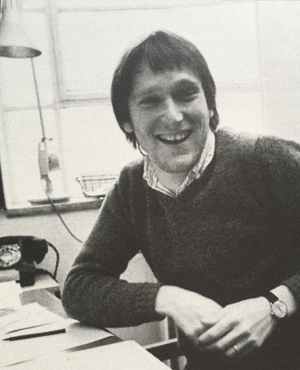Political economy: the survival kit for designers in the 1980s
 First published in Design, April 1979
First published in Design, April 1979This article was the first leader published under my editorship at Design magazine (1979-82). For all its narrowness and youthful excess, it marked out new territory for thinking about design
More than a century ago, when Britain was the workshop of the world, a discipline appeared which had the task of explaining why the country had got to the position she was in. The name of the discipline was political economy; and though the phrase has fallen into disuse with Britain’s decline, perhaps it’s time designers got to know what it means.
Before neoclassical economics arrived and began to tackle every real problem with a mass of unreal assumptions, classical economists – Smith, Ricardo and, arguably, Marx – established a tradition of economic analysis which was varied in method but unsurpassed in honesty and rigour. They threw themselves, not into the endless equations and convoluted curves of abstract supply and demand, but into the noisy, steamy, dirty lives led by entrepreneurs, workers, processes and products. They focused on men and machines, on the market and manufacture, on inventors and industry. But above all, they focused on the interaction between the wealth creators and the wealth created. So the couplet of falls off the tongue as an elision: political economy.
The concerns of the classical economists should form some of the major concerns of designers in the 1980s. Already, most designers are less than satisfied with theory pretending to represent the practice of design management. Instead, designers will be forced to learn the real and messy business of organising design within ever tightening commercial constraints.
More and more, in-house designers in manufacturing industry will require foresight to make their products beat the international competition in these protectionist times. They will have to conduct a detailed scrutiny of the reasons for and the extent of import penetration; and they will find themselves making a closer evaluation of the design ingredients of export success. They will have no choice but to give careful attention to the product sectors that will be the key to any reversal of Britain’s balance of payments deficit.
Designers will need to concentrate on the mechanics of innovation, just as the classical political economists did. They must acquaint themselves fully with the costs and benefits of R&D, ridiculing it where is application is uncertain and holding it up as an example to all where it results in successful new product development.
Inevitably designers will be absorbed in technology to a larger degree them before. This will not find favour with everyone, but there is little alternative. The 1970s have been as much characterised by the emergence of new technologies as by recession. Designers should learn to master the intricacies of both. They must be able to spell out the logic of new technologies to industry: how they will affect prices, where they will be introduced, the effect they will have on capital investment and, most important, the way they will transform the nature of artefacts around us.
What about graphics, interiors, the environment and so on? In these areas, where consumers and their tastes are peculiarly sovereign, industry will ask increasingly that decoration should improve sales, that extravagance should be economically justified, and that atmosphere should be attractive to more than a few. Here, as elsewhere, it is no good designers putting defensive inverted commas around the word ‘aesthetics’ every time the relevance of design is questioned. They should stick to their guns and defend aesthetics – but by convincing industry of its direct value. That is what a grounding in political economy will allow them to do.
@jameswoudhuysen I use my bicycle every day. Exercise and access to shopping without any parking meters and all that fuzz. But alfa-cyclists are the worst. They are competing at 40 mph and always acting rudely to get where they are going.
A PRO-CAR CYCLIST WRITES: 12-1pm tomorrow on #R4, will be talking bikes, cars, pedestrians, public transport – and #JeremyVine
Stimulating piece on the #CrisisOfCustomerService by clever @ClaerB @FT.
All that Clinton-era #CustomerExperience guff was always for the birds - certainly compared with, er, price.
The new thang? Often there is NO service - and thus no #CX!
Articles grouped by Tag
Bookmarks
Innovators I like

Robert Furchgott – discovered that nitric oxide transmits signals within the human body

Barry Marshall – showed that the bacterium Helicobacter pylori is the cause of most peptic ulcers, reversing decades of medical doctrine holding that ulcers were caused by stress, spicy foods, and too much acid

N Joseph Woodland – co-inventor of the barcode

Jocelyn Bell Burnell – she discovered the first radio pulsars

John Tyndall – the man who worked out why the sky was blue

Rosalind Franklin co-discovered the structure of DNA, with Crick and Watson

Rosalyn Sussman Yallow – development of radioimmunoassay (RIA), a method of quantifying minute amounts of biological substances in the body

Jonas Salk – discovery and development of the first successful polio vaccine

John Waterlow – discovered that lack of body potassium causes altitude sickness. First experiment: on himself

Werner Forssmann – the first man to insert a catheter into a human heart: his own

Bruce Bayer – scientist with Kodak whose invention of a colour filter array enabled digital imaging sensors to capture colour

Yuri Gagarin – first man in space. My piece of fandom: http://www.spiked-online.com/newsite/article/10421

Sir Godfrey Hounsfield – inventor, with Robert Ledley, of the CAT scanner

Martin Cooper – inventor of the mobile phone

George Devol – 'father of robotics’ who helped to revolutionise carmaking

Eugene Polley – TV remote controls

Thomas Tuohy – Windscale manager who doused the flames of the 1957 fire



0 comments